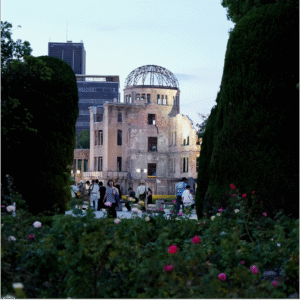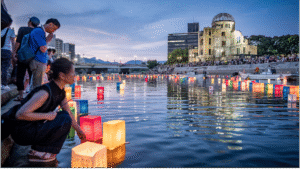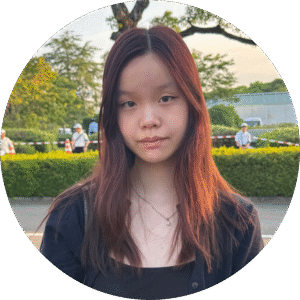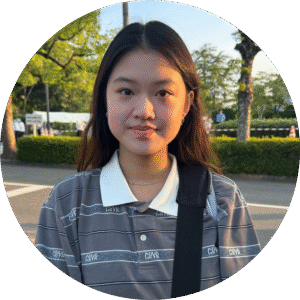Harbingers’ reporters from the 2025 Japan Newsroom explore the legacy of the Hiroshima bombing

August 6, 2025, Hiroshima, Japan. Genbaku Dome (A-Bomb Dome) seen from the Peace Memorial Park.
Picture by: Katie Chen
Article link copied.
August 7, 2025
Hiroshima 80 years on: What happened and why it still matters
and
Klara Hammudehin Hiroshima, Japan
Eighty years after the atomic bombing of Hiroshima, the city remains a powerful symbol of both devastation and resilience. While the attack played a decisive role in ending World War II, its effects on survivors, international affairs and global nuclear policy are still felt today.
This article explores what happened before, during and after the bombing.
What happened?
On August 6, 1945, the United States dropped the world’s first atomic bomb – nicknamed Little Boy – on the Japanese city Hiroshima. Approximately 140,000 people died by the end of that year, while another 210,000 survived, many of whom faced long-term health consequences from intense radiation exposure.
Three days later, a second, more powerful counterpart – Fat Man – was dropped on Nagasaki.
The devastation led to Japan’s surrender. After the defeat of the Axis forces in Europe earlier that year, Japan continued fighting against the Allied Powers, led by the United States, United Kingdom, China and the Soviet Union. On August 10, a day after the destruction of Nagasaki, Japan offered a conditional surrender, which the Allies rejected. On August 14, Japan accepted the terms of unconditional surrender.
The following day marked Victory over Japan, but the formal surrender did not take place until September 2, aboard the USS Missouri, officially ending World War II.
Harbingers’ Weekly Brief
Was it justified?
The US government’s decision to use atomic bombs remains widely disputed.
Lieutenant General Leslie R Groves,United States Army Corps of Engineers officer, who oversaw the creation of the Pentagonand directed the Manhattan Project,commented after the war: “The atomic bombings of Hiroshima and Nagasaki ended World War II. There can be no doubt of that. While they brought death and destruction on a horrifying scale, they averted even greater losses – American, English and Japanese.”
Supporters of the bombings argue they saved lives by preventing a land invasion of Japan,which would have resulted in enormous casualties on both sides. The bloody battles for Iwo Jima and Okinawa,where kamikaze and other tactics led to high death tolls, convinced many that Japan would not surrender otherwise.
However, the critics argue that Japan was already on the brink of surrender and that the bombings were unnecessary. The second strike on Nagasaki has been highly criticised for being rushed, as they were carried out before Japan could fully process and respond to the destruction in Hiroshima.
In his memoir “I Was There,” Admiral William Leahy, chief of staff to the president, wrote: “It is my opinion that the use of this barbarous weapon at Hiroshima and Nagasaki was of no material assistance in our war against Japan. The Japanese were already defeated and ready to surrender.”
Aftermath and reconstruction
Despite the destruction, Hiroshima’s reconstruction began almost immediately. Within a week, the city had partially restored its streetcar operations, water systems and light sources.
However, full-scale reconstruction did not begin until after Japan’s official surrender. At first, Hiroshima faced many rebuilding challenges, including difficulties with finances, human resources and materials. To address these challenges, the government passed the Hiroshima Peace Memorial City Construction Law in 1949, offering financial support, land and repurposing former military property for reconstruction.

The 'Toro Nagashi' Lantern Floating ceremony, a tribute to the victims of the Hiroshima atomic bombing.
Picture by: Little valleys | Alamy
One major debate among Hiroshima citizens was whether to preserve the ruins or erase reminders of war. Eventually, the city embraced a dual identity: a rebuilt urban centre and a living peace memorial.
At the heart of Hiroshima’s Peace Memorial Park stands the Genbaku Dome (A-Bomb Dome), the only building near the blast’s hypocenter to partially survive. As the explosion was almost directly overhead, the building was not subject to the blast wave and able to retain its shape.
Originally the Hiroshima Prefectural Industrial Promotion Hall (built in 1914), it remains preserved as a UNESCO World Heritage Site and a haunting reminder of the horrors of nuclear war.
How many survivors are still alive?
The survivors of Hiroshima and Nagasaki are known as hibakusha, and those who suffered the effects of both bombings are known as nijū hibakusha.
Hibakushas suffered long-term health effects, especially leukemia, cancer and the consequences of psychological trauma. They were also subject to discrimination limiting their marriage and employment prospects.
As of 2025, fewer than 100,000 hibakushas are still alive.
Nuclear proliferation today
Despite international calls for disarmament, nuclear weapons remain a key component of global military strategy.
The bombings of Hiroshima and Nagasaki sparked global fear, leading to the doctrine of Mutually Assured Destruction (MAD), a political and military assumption that the full use of nuclear weapons would result in the annihilation of all parties involved.
While Hiroshima and Nagasaki have since become symbols of peace and led anti-nuclear movements, nuclear proliferation has persisted. During the Cold War, despite the United Nation’s call for disarmament in 1946, the Soviet Union, United Kingdom, France and China developed their own nuclear weapons.
The most significant global treaty against nuclear weapons is the Non-Proliferation Treaty (NPT), signed by 191 countries, including five of the nine nuclear-armed countries: the United States, Russia, China, France and the United Kingdom. The agreement entered into force in 1970.
However, India, Pakistan, Israel and North Korea, have not joined the treaty. Iran, though a signatory, has repeatedly breached transparency obligations and continues to resist full cooperation with the International Atomic Energy Agency (IAEA).
Today, an estimated 12,000 nuclear warheads are held by nine countries. Some, like China, are expanding their stockpiles rapidly, reportedly adding over 100 warheads annually. Modern nuclear weapons are also far more powerful than those used in 1945, with a potential to kill millions.
Written by:

Writer
Bali, Indonesia
Born in 2007 in Malmo, Elias has studied in Sweden, Chile, California, North Carolina, and Bali. He is interested in business, entrepreneurship, management and international relations and plans to study along those lines. For Harbingers’ Magazine, he writes about economics, society, international relations, and sports.
In his free time, Elias plays football, does Maui Thai, goes to the gym, enjoys riding motorbikes and spending quality time with friends and family. He has played high level football his entire life and runs a microbusiness teaching football to young athletes.
Elias speaks English and Swedish.

Contributor
Hong Kong
Born in 2007 in New York, Daniel studies in Connecticut, USA. He is interested in politics and philosophy and plans to study Politics, Philosophy, and Economics. For Harbingers’ Magazine, he writes about politics, AI, technology and economics.
In his free time, he enjoys jiu-jitsu, GeoGuessr, spikeball and chess. He also is ambidextrous and wishes to travel the world.
Daniel speaks English, Chinese and is learning French.

Writer
London, United Kingdom
Born in 2009 in Kyiv, Ukraine, Lukas Abromavicius studies in London, United Kingdom. He is interested in economics and plans to study finance. For Harbingers’ Magazine, he writes about economics and politics.
In his free time, Lukas plays volleyball, basketball, chess and enjoys playing the saxophone.
He speaks Ukrainian, Russian, Lithuanian, French, English and Spanish.

The Harbinger Prize 2024 (Overall Winner)
Writer
United States
Reva Sobti was born in 2008 and currently studies in the United States. She plans to pursue a higher education at one of the T-25 universities to major in Sociology, Business, or Biology. Reva won the Harbinger Prize 2024 and plans to continue writing about social issues.
After successfully completing the Essential Journalism course, Reva became a writer for Harbingers’ Magazine starting in March 2025.
In her free time, she loves to read, watch movies, bake, play volleyball, and eat good food. A fan of travelling, Reva has so far visited 16 countries.
She speaks English, Hindi, Punjabi and Spanish.

Contributor
Hong Kong
Born in 2009 in Hong Kong, Jennifer studies in New Hampshire, US. She is interested in design, business, and economics, and plans to study at an American university. For Harbinger’ Magazine, she writes about architecture, international relations and human rights.
In her free time, Jennifer enjoys travelling, drawing, and playing sports. She also participates in volunteer programs with children.
Jennifer speaks English, Cantonese, and Chinese.

Politics Section Editor 2025
Warsaw, Poland
Born in 2008 in Warsaw, Poland, Klara joined Harbingers’ Magazine to cover international affairs, crime, and music.
She joined the magazine in March 2024, writing numerous articles on politics and music. In 2024, she reported on the US presidential elections on the ground and, in February 2025, covered the Middle East crisis from Amman, Jordan. Her strong writing skills led to her appointment as Politics Section Editor in March 2025. Simultaneously, she will serve as the Poland 2025 Presidential Election Newsroom Editor.
In the future, Klara plans to study psychology, international politics, or criminology, preferably in the United States.
In her free time, she enjoys reading, dancing, listening to music, and exploring pop culture—particularly how Broadway and West End adapt classic Disney stories into musicals.
Edited by:





Pictures by:

🌍 Join the World's Youngest Newsroom—Create a Free Account
Sign up to save your favourite articles, get personalised recommendations, and stay informed about stories that Gen Z worldwide actually care about. Plus, subscribe to our newsletter for the latest stories delivered straight to your inbox. 📲
© 2025 The Oxford School for the Future of Journalism



